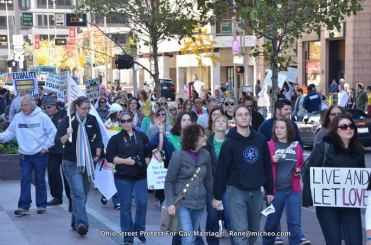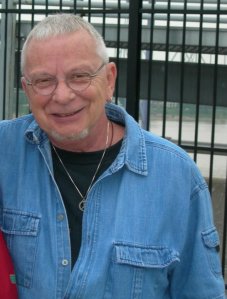Most people, when they hear about an injustice, think to themselves that someone should do something about that. The general feeling is that if it is important enough, someone else will do something about it. Today, civil disobedience and protesting are often thought of as things of the past. People are too busy, have other concerns, or just don’t want to get involved. This has never been the attitude of John Maddux, who has been an advocate for social causes since the late 1960s. Through his passion and his dedication to raising awareness of social causes, John Maddux has been able to show the importance of what people can do to change the wrongs around them.
John’s first encounter with injustice happened when he was just a child. While vacationing in Georgia, which still has Jim Crow laws at the time, John tried to take an African-American boy to the same bathroom that he had just used. “A man started yelling at me,” John said. “I started crying. I didn’t know what I had done wrong.” Later, when John’s parents explained it all to him, he was confused and horrified. “I was raised in the Quaker tradition,” John stated. “There is a deep sense of social justice that we are taught.” The need to get involved began in John when he started to understand what injustice meant at a personal level and wanted to see the injustice changed.
From civil rights to gay rights, John has participated in protests, worked with local and national groups, and taught classes on civil disobedience. Though John participated in various protests as a young man, his major work with social change has been since 1992. “I came out then,” John explained. “I realized the need and just kept volunteering. I continued to get more and more involved.” John has served as board members of various local organizations, including the Greater Cincinnati LGBT. He was the president of that organization for three years, during which time he helped create a community center for LGBT people to gather. John’s earlier involvement in protesting was not as regular, but no less important to him.
John’s first awareness of the significance of public protest as a means for change came at a protest against the Vietnam War in Cincinnati. There, he met Joan Baez. Her passion and dedication to social change inspired him to become more involved in the community and take part in national protests. In 1970, four student protesters were shot and killed on the campus of Kent State University. He was in history class when the professor announced what had happened. “He told us that anyone who wanted to could leave without penalty,” John said. “I was the only one who did. The rest of the class booed me as I walked out.” John later joined other students who were protesting at Van Wormer Hall, which was the administration building at time. The protest lasted overnight until the police made the students leave. The University closed down shortly afterwards.
Protesting comes with some risks, including being arrested for breaking the law. Usually the charges are not for protesting, which is protected by the Constitution, but for peripheral reasons such as trespassing. “I’ve been arrested in a lot of places,” John laughed. He was arrested near Seattle as part of a protest against the shipping of nuclear weapon parts. He was also arrested in Maryland for protesting in front of the Center for Disease Control because of the lack of money being used for AIDS research. Another time John was arrested in Washington DC for blocking the steps of the Supreme Court while they heard a case about sodomy laws in Georgia.

Though John has participated in protests nationally, he has done most of his work locally in Cincinnati. He is most proud of a boycott he helped organize in 1988. At the time, he was the Chair of the Task Force against Discrimination. The group was receiving complaints against a local restaurant chain, In Cahoots. The management had been firing employees for being gay. When the management refused to work with the group, they called for a boycott. Many other local groups joined the protest. According to John, “All in all, 33 groups joined the boycott. After one month, their business fell off by 2/3. They eventually gave in to our demands.” Not only were the fired employees given their jobs back, but they received back pay as well. The chain also agreed to a non-discrimination pledge. “It was the first national protest against a major corporation that was successful. Seeing something happen as a result of what you have done is very rewarding,” John said.
In order to pass along his own passion for social change, John teaches this topic in some of his classes. The courses cover civil disobedience, but also include political protest and community action as part of the class. “You can’t expect everyone to go out and commit civil disobedience. I just want them to get involved in the community somehow.” When John teaches his course on these issues, he uses service learning to engage the students in the ideas he is presenting. For the course, which uses service learning as its base approach, students must join an organization in the city that provides some social service to the community. In the past, students have worked food banks, boys and girls clubs, and political campaigns.
The course also includes readings by prominent figures in civil disobedience and political action, such as Henry David Thoreau, Martin Luther King, Jr., Mahatma Ghandi, Elizabeth Cady Stanton, and Joan Baez. “I also include one of my own articles on civil disobedience,” John said. “Because it is important for students to know what true civil disobedience involves.” John is very clear that most of what he has done is protesting, and not true civil disobedience. His article covers what is required for an act of protest to be considered legitimate civil disobedience.
John lists four elements that must be present for legitimate civil disobedience. First, the law in question must be broken as part of the protest. He cites a protest in London as an example. “In a major London park, probably Hyde Park, a group of gays and lesbians got together for a Kiss-In to protest anti-gay laws in Britain. There was a law that forbade any public displays of affection between same sex people, and they broke the law as part of the protest.” Secondly, the protesters must accept the legitimacy of the system of government. “It’s not a coup or a revolution,” explains John. The act must also be done in public, and the protesters must accept responsibility for their actions.
The purpose of the course is to make students aware of the legitimacy of public protest. “This right is guaranteed in the Constitution. A lot of people think of protesters as disgruntled. That’s not what protesting is about. It’s about giving back to the community.” The reaction of the students to the class was “overwhelming,” according to John. “They really enjoyed it. That class got the highest evaluations I have ever gotten.”
Making a difference in the community at the most basic level starts awareness. Awareness is part of what inspires John to teach classes on community involvement. “I want students to see the value and fulfillment of getting involved,” John says. John’s own activities serve as an example to not just his students, but to anyone who has worked with him. John believes social engagement is central to any democracy, as it is through the involvement of its citizens that help keep a democracy strong. The dedication of a few can inspire others to get involved, and it is the passion of John’s beliefs that clearly demonstrate the difference that people can make, both at a local and national level.
